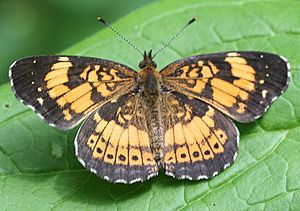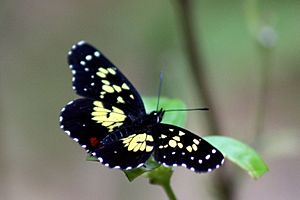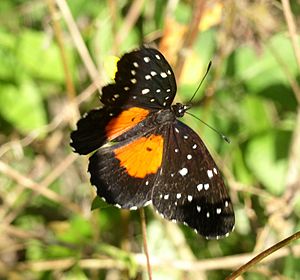Chlosyne facts for kids
Quick facts for kids Chlosyne |
|
|---|---|
 |
|
| Silvery checkerspot | |
| Scientific classification |
|
| Kingdom: | Animalia |
| Phylum: | Arthropoda |
| Class: | Insecta |
| Order: | Lepidoptera |
| Family: | Nymphalidae |
| Tribe: | Melitaeini |
| Subtribe: | Chlosynina |
| Genus: | Chlosyne Butler, 1870 |
| Synonyms | |
|
|
Chlosyne is a special group of butterflies found across North and South America. These colorful insects belong to a large family called Nymphalidae, often known as brush-footed butterflies. Many Chlosyne butterflies are called "checkerspots" or "patches" because of the unique patterns on their wings.
Contents
What are Chlosyne Butterflies?
Chlosyne butterflies are known for their medium size and their striking wing patterns. Their wings often have a mix of black, orange, yellow, and white spots or bands. These patterns help them blend in with their surroundings or warn predators that they might not taste good.
Where Do Chlosyne Butterflies Live?
You can find Chlosyne butterflies in many different habitats. They live all the way from Canada down to South America. They prefer open areas like meadows, fields, and sunny forest edges. Some species also live in deserts or mountainous regions.
What Do Chlosyne Butterflies Eat?
Adult Chlosyne butterflies mostly drink nectar from flowers. Nectar gives them the energy they need to fly and find mates. Their favorite flowers include sunflowers, asters, and thistles.
The young butterflies, called caterpillars, have a different diet. They munch on the leaves of specific plants. For example, some Chlosyne caterpillars love to eat sunflower leaves. The type of plant a caterpillar eats is very important for its growth and survival.
Different Kinds of Chlosyne Butterflies
Scientists have identified many different species within the Chlosyne group. They often group these species based on their similar features. Here are a few examples of the interesting Chlosyne species:
The Lacinia Species Group
This group includes butterflies like the Bordered Patch and the Crimson Patch. The Crimson Patch, for instance, has bright red patches on its wings, making it very noticeable. These butterflies are often found in warmer regions.
The Charidryas Species Group
Butterflies in this group include the Northern Checkerspot and the Hoffmann's Checkerspot. They are often found in western North America. The Northern Checkerspot can have many different color patterns, even within the same species!
The Harrisii Species Group
This group features butterflies like Harris's Checkerspot and the Silvery Checkerspot. The Silvery Checkerspot gets its name from the silvery-white spots on the underside of its hindwings. These butterflies are common in eastern North America.
The Thessalia Species Group
Examples from this group include the Leanira Checkerspot and the Theona Checkerspot. These butterflies often have striking patterns and are found in various parts of North and Central America.
Life Cycle of a Chlosyne Butterfly
Like all butterflies, Chlosyne species go through a complete metamorphosis. This means they have four main stages in their life:
- Egg: The female butterfly lays tiny eggs, usually on the leaves of specific host plants.
- Larva (Caterpillar): The eggs hatch into caterpillars. These caterpillars spend their time eating and growing. They shed their skin several times as they get bigger.
- Pupa (Chrysalis): Once the caterpillar is fully grown, it forms a chrysalis. Inside the chrysalis, amazing changes happen as the caterpillar transforms into a butterfly.
- Adult Butterfly: Finally, the adult butterfly emerges from the chrysalis. It will then fly, find a mate, and lay eggs to start the cycle all over again.
Why are Chlosyne Butterflies Important?
Chlosyne butterflies, like many other insects, play an important role in nature. As adults, they help pollinate flowers when they drink nectar. This means they help plants make seeds and fruits. Their caterpillars are also a food source for birds and other animals, making them a part of the food web. Studying these butterflies helps scientists understand more about ecosystems and how different species interact.
See also
 In Spanish: Chlosyne para niños
In Spanish: Chlosyne para niños



